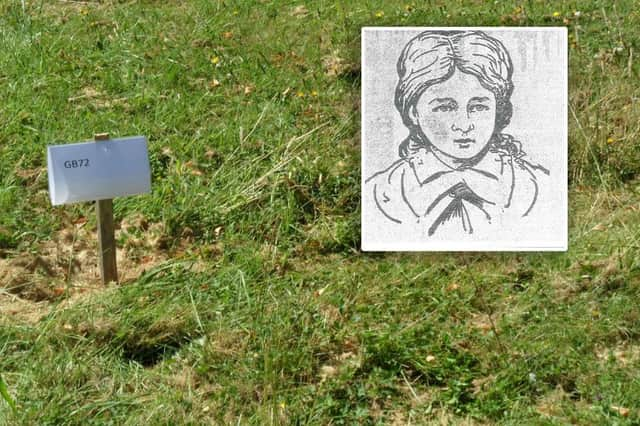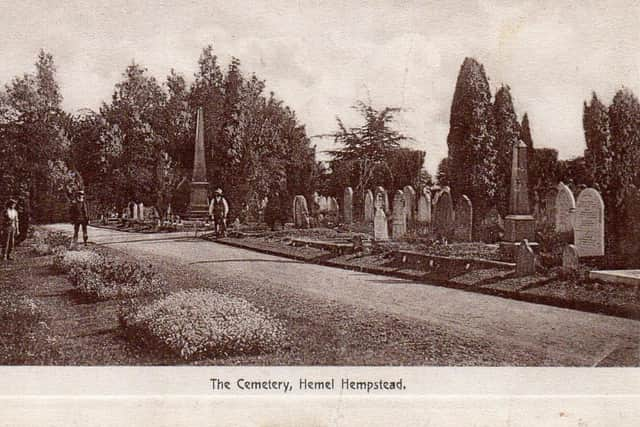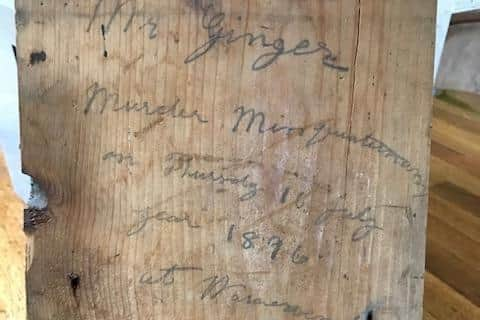The brutal murder that gave Quartermass Road and Quartermass Close in Hemel Hempstead their name


It is 1896, and page 5 of The Hemel Hempstead Advertiser of the July 18 bore the headline ‘Horrible Discovery near Hemel Hempstead – A Girl Murdered – Great Excitement’.
This was the report of the terrible discovery of the body of a young girl, who had been brutally bludgeoned and knifed to death on the previous Thursday, July 16.
Advertisement
Advertisement
Naturally with the local grapevine, people of the town and the area surrounding it were already aware of the terrible deed.


It would not take long for the murder to be reported in the National Press. Less than a week later the media reported that ‘The comparatively unknown Borough of Hemel Hempstead had become a familiar word (or two words) in the mouth of the nation’ as their local reporter put it. The edition of July 25 went on to give details of the gruesome discovery, and provided a sketch of Warners End farm, outside of which the inquest had taken place.
A cross on the sketch marked the window of the room where the victim had been laid.
It was on July 16 that the badly mutilated remains of the young girl were found in the Boxted Farm area, by one William Ginger, who was a shepherd employed by Mr Procter, the owner of Boxted Farm.
Advertisement
Advertisement
The victim had massive injuries to her head and throat, and she was, as one would expect, saturated in her own blood.


Blood tracks in the lane determined that the body had been dragged for some 40 yards in an attempt to conceal it, and blood was found on the gate of the clover field where she was eventually found.
The attack had taken place in a lane where two carts would have had extreme difficulty passing each other.
The ‘Advertiser’ reporter had arrived at 8pm, as darkness was setting in. Superintendent Frogley had already arrived as had Inspector Martin and Sergeant Francis. Doctor Hubbard had also been summoned earlier, but there was nothing he could do, other than confirm the death and note the injuries inflicted. The body was then taken to the empty Warners End Farm.
Advertisement
Advertisement
The victim of this heinous crime was Katharine Mabel Quartermass of nearby Bodds End, aged just 12. She was the daughter of Henrietta and John Smith Quartermass, a Hawker. The family was well known locally, and Katharine was often seen selling ice cream in Berkhamsted.
An inquest was held at Warners End Farm, unusually in the open air outside the front of the farm.
Present were such locally well-known names as Cranstone, Randall, Kitchener, Beckley, Bayley, Payne, Williams, Oldfield, Ray, Green, Glenister, Cheesewright and I. Mooney. Mr Cranstone was duly elected Foreman.
It was observed by Mr Kitchener that the attack had taken place in what was known locally as ‘Hell Lane’, more recently ‘Counters End Lane’.
Advertisement
Advertisement
Mr Grover, the Coroner, began by stating that the evidence to be taken that day would be purely the identity of the victim.
Mr Quartermass stated that Katharine resided at the family home, and that she had set out that day to collect milk from Boxted Farm, as she had done many times. He and his wife had been in Apsley on business until the early evening, when they returned to be told of her death. He
said that he believed that someone had attempted to steal the full milk can from her, and that she had attempted to stop them from doing so - ‘She would’, he said, ‘That is, in my opinion, how the assault began’.
He had been able to identify the body of his daughter, the milk can, and her hat and umbrella.
Advertisement
Advertisement
Mrs Elizabeth Allen, a Servant at Boxted Farm, testified that Katharine was a regular visitor to the farm, and that it was around 5pm that day when she called for a quart of milk, and that she had left for home straight away.
George Ginger was next to give his account. He had been at work until 5.30pm, when he left to check on his sheep. It was on the way that he noticed, just over the hedge, an umbrella laying in the field.
When he crossed over and climbed into the field he saw a milk can and lid laying further into the field, and when he got to it he saw there was very little milk left, perhaps just a tablespoonful.
It was then that he saw what appeared to be a body lying by a hedge some 200 yards away, but applied his own interpretation to this, and carried on to check the sheep. It was on his return that he could see it was the body of a young girl with her own blood-soaked cloak covering her, but he was able to see her face.
Advertisement
Advertisement
He returned directly to the farm, and ‘told them there’ of what he had found, and after telling his son, he went off to inform Mr Quartermass. However, on the way, he met with another of the daughters and told her he believed her sister to be dead.
Dr Hubbard then told the inquest he had arrived at around 7.15pm, he inspected the body under the hedge and had been able to track the trail of blood some thirty yards. He had sent for his camera and had taken a number of photographs which he had later printed.
Later, at Warners End Farm, Dr Hubbard had examined the body more thoroughly, finding six wounds to the face and neck, most probably caused by a knife. The worst of these was across the throat, almost severing the windpipe. This would in itself have been sufficient to cause death. There was no evidence to suggest the girl had been sexually assaulted.
While the evidence was being given the body had been washed and further injuries had been noticed. There was a bad bruise at the back of the right ear, and bruising and scratches to the right hand and wrist.
Following Dr Hubbard’s evidence the inquest was adjourned.
Advertisement
Advertisement
From the very beginning, public suspicion had been aimed at George Ginger, and on July 20 he was arrested and taken to Hemel Hempstead Police Station. He was taken before the justices the next day.
Reporters were not admitted to the proceedings, and the Advertiser’s reporter commented that this was, in his experience the first time a police court had been held ‘in camera’. The end result was that Ginger was remanded in custody.
It was widely understood that Ginger would appear before Captain Cooper and Mr Lewis Evans at the Sessions Court. As would be expected, crowds gathered to see the accused on his way to trial at the Town Hall, and between 200 and 300 people pushed their way into the Chamber.
However, the prisoner did not appear, and it soon became known that the trial would actually take place at Hemel Hempstead Police Station. It was not long before a large crowd gathered there.
Advertisement
Advertisement
Superintendent Frogley informed the court of his findings, saying he had removed clothing and a knife from the accused. He requested an adjournment for eight days which was duly granted.
A further eight days later, July 29, Ginger appeared at Berkhamsted Sessions Court.
Mr C. E. Longmore, Clerk to the County Council prosecuted on behalf of the treasury, and Mr R. S. Wood of High Wycombe appeared on behalf of the prisoner. Once again the Justices were Captain Cooper and Mr Lewis Evans.
Mr Longmore began his address by outlining the victim’s background. He stated that she lived at the family home, a small farm in Bodds End and that the family were poor but very respectable.
Advertisement
Advertisement
The incident had taken place some 1,576 yards from her home, and there appeared to be no clear motive as she had nothing to steal, and had not been outraged.
Lilian Quartermass was the first person called to give testament. She recalled having thought that ‘Katie’ had been much longer than usual. She had set out across the field towards Boxted House to find her, when she met Ginger who told her the awful news.
Mrs Mary Allen, servant to Mr Proctor of Boxted House Farm, repeated her statement as previously given.
Next, Alice Maud Geary informed the court she had seen Katharine alive as she drove to meet her sister, this was around 4.45pm. Further witnesses were duly called to try and establish times.
Advertisement
Advertisement
Following their testimonies, the case was adjourned for another eight days.
The case re-commenced on August 6 in a crowded courtroom before the same two justices.
However, on this occasion, a barrister, Mr Muir, appeared for the prosecution.
Richard Bachelor, a stockman, stated he was working at Boxted Cottage on July 16, and had seen Ginger cutting nettles in Fields End around 5pm, and that they had exchanged pleasantries.
Advertisement
Advertisement
William Garnet who also worked for the Proctors testified that he had seen Ginger at around 5pm going towards Bodd’s End, and then again, around half an hour later, on his way home.
Ginger had told him that he had discovered a woman or girl roughly half way down Green Lane (Possibly Green End Lane as we know it today).
Another witness Arthur Waterton said he saw Ginger at around the same time, and there had been no trace of blood on him. Two men who had been clearing a pond at Warners End Farm stated they had seen no strangers.
This was supported by Mark Cooley, who was at work scaring birds in the next field. He had actually heard a scream around 5pm, but had assumed it to be another person scaring birds away from the crops.
Advertisement
Advertisement
Harry Hill, a labourer, also employed to scare birds said he had also not seen any strangers.
Dr Arthur John Hubbard repeated the evidence he had given at the inquest, and produced his photographs as evidence. He said that he had been in no doubt whatsoever that the girl had been murdered close to the place where she had been found. He further stated that he had seen Ginger, and there was no evidence of blood on his person.
Sergeant Martin also testified as did Ginger’s employer Mr Proctor, who had been present when Ginger had been initially interviewed. Superintendent Frogley also repeated his evidence from the inquest, but added a list of the contents of Katharine’s pockets which were a penny, a ball, a key and a handkerchief.
Following the evidence for the prosecution, Barrister Mr Muir indicated that he did not wish to ask the magistrates to commit Ginger for trial, it was a matter for them solely.
Advertisement
Advertisement
Following a three minute adjournment, the magistrates returned and announced that the evidence presented was not sufficient to send Ginger for trial, and that therefore he was acquitted. The decision was heard outside the court and was met with mixed reactions.
The adjourned inquest resumed later, on August 12.
The verdict passed by the jury was that ‘Katharine Mabel Quartermass had died on 16th July 1896 at Hemel Hempstead. The cause of death was stated to be the result of haemorrhage from wounds to the throat, caused by person or persons unknown, and that she had been maliciously and without aforethought murdered’.
Following the inquest, George Ginger stated: “I think it very hard. I have been locked up for three weeks for nothing, and have had no money for three weeks.”
Later when he was asked if was feeling safe amongst the gathered crowd, he replied: “Oh yes, I do not think they will hurt me.”
Advertisement
Advertisement
The year 1896 ended without any further arrests for this heinous crime, and is as far as is known, it still remains unsolved to this day.
However, the case attracted such notoriety, newspaper reports have been seen from The Yorkshire Herald and The Teesdale Mercury!
Katharine’s funeral had taken place on Tuesday, July 21 at Marlowes Baptist Church. Only close mourners were allowed into the church. The service was conducted by the Reverend Wright Robinson, and among the mourners were Katharine’s sisters Lilian and Winifred, and her brothers Ernest, Cyril and Robert. The elm coffin bore the simple inscription – ‘Katharine Mabel Quartermass. Died 16 July 1896. Aged 12 Years’.
An estimated 1,500 to 2,000 men, women and children were present at The Hemel Hempstead Cemetery (Heath Lane) to witness the burial.
Advertisement
Advertisement
‘The Advertiser’ covered the funeral, and gave the following, poignant comment: “Never will Hemel Hempstead cemetery witness so sad a cortege and so affectingly simple an interment again, in all probability. We trust not.”
However, it is Katharine whose name lives on in the town where she has become, quite unwittingly, something of a local celebrity and part of the very history of the town. Indeed, if one takes the turn into Spring Lane from Warners End Road, and then the second turning to the left, they will find themselves in Quartermass Road, within which lays Quartermass Close, both on the site of Bodd’s End Farmhouse, from where Katharine set out on that terrible day. Both were named in her memory.
Amazingly, I have been contacted by a Lady, Karen Tonge, of Saddlers Cottages in Great Gaddesden. She had commissioned some building work (Approx. Circa 2010-11), which would involve the lifting of some floorboards on the landing.
After a short while the builder came down, and, handing her a floorboard from the landing, asked if this was something she had laid on for the building gang’s benefit or just for fun?
Advertisement
Advertisement
Imagine her shock to turn the floorboard over to find the following inscription (believed authentic): ‘’Mr Ginger murder Miss Quartermass on Thursday 16th July, 1896 at Warners End’’.
The work is quite naïve. The work of perhaps a frightened child, an innocent party who had been a witness to the murder but could not bring themselves forward for some reason? Perhaps even Ginger himself who may have believed he would get cleared of the crime at the time,
but whose conscience wanted the truth to come out at a later date?
(With acknowledgement to an original article by Mr Peter Ward Chambersbury News April 1998)
